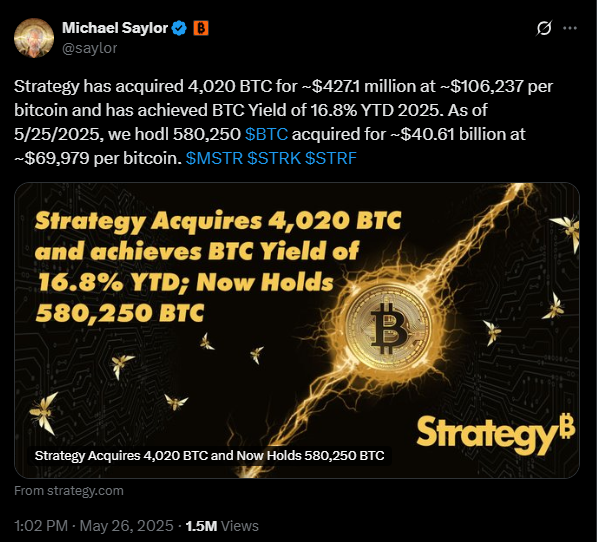Key Insights:
- Strategy has continued its aggressive Bitcoin accumulation, after purchasing another 4,020 BTC for $427.1 million.
- Meanwhile, the company is facing a class-action lawsuit about misleading statements with its Bitcoin investment strategy.
- Executive share sales by Strategy directors and CFO have also been major problems.
Michael Saylor’s Strategy, formerly known as MicroStrategy, is showing no signs of slowing down its aggressive Bitcoin strategy. Despite being hit with a class-action lawsuit and seeing its stock drop by over 12% in a week, the company has once again added thousands of BTC to its already massive holdings.
As Bitcoin continues attempting to flip $110,000 into support, Strategy’s commitment to accumulating more digital gold shows a great deal of confidence in the cryptocurrency’s future.
Another Major Bitcoin Purchase
On 26 May, Strategy announced that it was purchasing another 4,020 BTC. For this purchase, it spent approximately $427.1 million at an average price of $106,237 per coin.
This latest buy brings the company’s total Bitcoin holdings to a staggering 580,250 BTC, all of which were acquired for roughly $40.6 billion at an average price of $69,979 each.

Bitcoin is now trading at around $110,000, and the current market value of Strategy’s BTC stash is now worth over $63.7 billion. Because of this, the company already has a year-to-date return of nearly 17%.
May alone has seen Strategy’s buy Bitcoin four times, in continuation of its trend of accumulating BTC regardless of market conditions.
Lawsuit Looms Over Strategy
While Strategy continues to add to its crypto war chest, not everything is smooth sailing.
Just a week before the latest buy, the company was hit with a class-action lawsuit. The complaint revolved around accusations that Strategy’s executives made false and misleading statements about the profitability of their Bitcoin investment strategy.
This lawsuit was filed on 19 May, and claims that shareholders suffered financial harm due to these misrepresentations.
The filing appears to have rattled investors, and led to a stock drop on $MSTR from around $420 to $369 per share. In essence, the stock dropped by nearly 12% in only a few days.
Executive Share Sales Raise Eyebrows
Adding fuel to the fire, Strategy’s leadership has been offloading shares amidst the legal troubles and price volatility.
According to regulatory filings, Strategy director Jarrod Patten sold 2,650 shares between May 16 and 21. This netted him nearly $1.1 million and since April 22, Patten has offloaded a total of 17,050 Class A shares, worth approximately $6.7 million.
In addition to this, Strategy’s Chief Financial Officer Andrew Kang sold 2,185 shares on May 23, and cashed out nearly $720,000. While these insider sales may be routine for executives managing their personal finances, the timing, especially being so close to both the lawsuit and another major BTC purchase has caused much investor unease.
Stock Slides, But Long-Term Gains Remain Impressive
Despite the recent dip in stock price, Strategy’s long-term performance tells a different story.
Since pivoting to a Bitcoin-focused business model in 2020, the company’s stock has soared from under $15 to nearly $370 and has gained more than 2,400%.
While the latest lawsuit and executive stock sales may have shaken short-term confidence, Strategy is still one of the best-performing public companies over the past five years.
Several smaller public companies are now copying Strategy’s playbook in a bid to enhance shareholder value.
Overall, according to CoinGecko, Bitcoin was trading around $109,826 at the time of the purchase announcement. This upswing in price could be a signal that more upside could be on its way. If history is any guide, Strategy’s bet on BTC may continue to reward those willing to endure the volatility.
The company has already turned billions in unrealized profits, and with the crypto market gaining traction on Wall Street, it seems Strategy is in no rush to change course.
